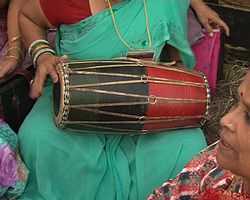Madal
|
Madal |
The Madal (Nepali: मादल), used mainly for rhythm-keeping in Nepalese folk music, is the most popular and widely used hand drum in Nepal. The Madal consists of a cylindrical body with a slight bulge at its center, closed on both ends. (The sides are often referred to as "heads"; one head is smaller than the other).
The madal has a strand that goes around the waist of the person playing it to hold it horizontally. Playing technique involves rhythmic striking of either of the ends (heads) with the palm of the hand. The heads vibrate to produce sound when struck.
This typical Nepalese percussion instrument is the backbone of most of Nepali folk music. The well-known Nepali musician Ranjit Gazmer introduced this instrument to Bollywood music, when he started working under Rahul Dev Burman, and has used it in numerous Bollywood songs such as 'Hum dono do premi duniya chhod chale', 'Kanchhi re kanchhi re' and many others. There is also a madal drum among certain Adivasi groups.It produces influencing or exciting type of sound providing entertainment for people .
History
The Madal originated in the Magar community of Nepal.[1]
Nomenclature and construction
The ancient name of Madal was Mardal (मर्दल in Nepali).
Typically, a wooden log is carved so as to form a hollow cavity, called Ghar (घार). The two opposite openings are covered with stabled stone or wood. The stone or wood on either head also consists of a black inner concentric circle. This layer is made up of a black substance known as Khari (खरी), which is the powdered mixture of Kansh (काँश) and Kit (किट). This black substance give the wood or stone weight and cause the tone to reverberate like a low pitched bell.[2] The heads are not of the same size; the larger and the smaller heads are often referred to as male and female respectively.[3] The madal's other feature are the strands that overlay the central body. These strands, also made up of stabled wood or stone, are used to tune the instrument. At the end of the making it is played beautifully!
See also
- Maddalam
- Dholak
- Damphu drum
References
- Anmol, Amrita Priyamvada (2009). Encyclopaedia of Indian Musical Instruments, Vols. 1 to 3 :, xxxvi, 720 p, 3 Vols, figs, ISBN 9788126140770
- L.S. Rajagopalan, L.S. (2010). Temple Musical Instruments of Kerala. Edited by A. Purushothaman and A. Harindranath, Sangeet Natak Akademi, xvi, 168 p, ISBN 8124605440
